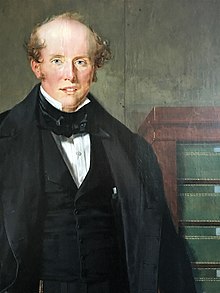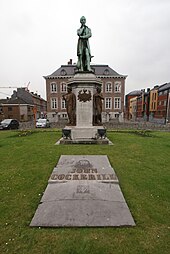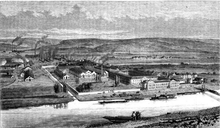John Cockerill
John Cockerill (born August 3, 1790 in Haslingden , Lancashire , † June 19, 1840 in Warsaw ) was an English-born Belgian industrialist.
Life
John Cockerill was the son of the machine manufacturer William Cockerill, Senior and Elisabeth (Betty) Charles and brother of William Cockerill, Junior and James Cockerill , who came from England and worked in Verviers and Liège . As a boy of twelve, John joined the textile machine factory founded by his father in Verviers in 1797, which he and his older brother James took over in 1807 after their father had built a new factory in Liège. In 1810 John succeeded his father and took over the technical management of the factory and finally in 1813 overall management together with his brother James. Two years earlier, John Cockerill, his father, and his brother James were granted French citizenship in recognition of their achievements. After John Cockerill had also acquired Seraing Castle from King Wilhelm I of the Netherlands in 1817 and converted it into the main central iron making factory, the brothers built the largest iron foundry and machine factory in Europe here, which laid the foundation for the development of a widespread company and from which later the Cockerill-Sambre developed, whose main market was to be France. The investment amounted to 17 million French francs . In addition to the two coal mines and an ore mine, blast furnaces , a steel and rolling mill, a boiler forge and a machine factory were operated. Around 2500 people were employed in the Cockerill company.
In 1823 James Cockerill left the joint company in order to concentrate more on the Aachen and Stolberg area. He sold his holdings to the King of the United Kingdom of the Netherlands . As a result, Cockerill received financial support from both the Dutch royal family and the Dutch government for the next few years. As part of a major order, he now produced, among others, for the Dutch shipbuilder Gerhard Moritz Roentgen , the Dutch Navy and the Rhein-Main-Schifffahrtsgesellschaft. After the Dutch King Wilhelm I withdrew from the company during the Belgian Revolution , John Cockerill took over his shares, but further difficulties in the context of the post-revolutionary recession endangered the bloated company.
Cockerill is considered a pioneer of industrialization in Belgium. He died surprisingly in 1840 of complications from typhoid fever in Warsaw on his return from a business trip to St. Petersburg . Years earlier, the childless John Cockerill had stipulated in his will that his shares in the company and the management would go to his personal secretary and son-in-law of his brother James, Barthold Suermondt , whose father IJman Dirk Christiaan (1792–1871) had also been a shareholder in the company for many years the total assets of Cockerill should be divided between Barthold and his brothers.
John Cockerill married Johanna Friederike Pastor (1795–1850) in September 1813 as part of a double wedding, while his brother James married her sister Caroline Elisabeth Pastor (1791–1836). The marriage of John and Johanna Cockerill remained childless. After his sudden death, John Cockerill was buried in Warsaw, but in 1867 he was transferred to Seraing and finally buried in the courtyard. A few years later the city of Seraing built a monumental monument on the Grand-Place for its most important citizen, which was inaugurated on October 22, 1871. Another monument was erected to him in Ixelles / Elsene opposite the Gare de Luxembourg and in Liège a square on the Meuse was named after him.
Act
Together with his brother James, John Cockerill set up a modern wool spinning and mechanical engineering company in a former barracks in Berlin in 1814 and made a significant contribution to the progress of Berlin's economy. While the finest yarns for fine cloth were produced in the spinning mill, the machine factory produced a wide range of modern machines and tools, mainly for textile production, which found good sales in Prussia and outside the country's borders and made a major contribution to modernizing the Prussian economy. After a large part of the Berlin works had been destroyed by a fire in November 1831, the brothers John and James rebuilt the factory, but due to bureaucratic obstacles they felt compelled to end their Berlin activities in 1836 and to sell the factory facilities.
In 1832 he bought the Herrenberg lead and zinc ore mine between Verlautenheide and Haaren . In the immediate vicinity of the James mine , which belonged to his brother, he founded the St. Heinrich-Zinkhütte in Münsterbusch in 1837 . A year later, John Cockerill brought his shares in the St. Heinrich-Zinkhütte, the Herrenberg mine and other mine holdings into the newly formed Metallurgische Gesellschaft zu Stolberg . Heavy machinery factories, as well as paper and glass factories were also established. In total, the Cockerill company comprised around 60 different operations in Belgium, France, Spain, Germany, Poland and Russia.
The headquarters in Seraing was founded with an initial capital of 17 million French francs. In addition to mines (coal and ore) and a steel mill, a steel and rolling mill, a boiler forge and a machine factory were operated. 22 steam engines were in use. The plant employed 2,500 people. In 1829 Cockerill appointed his wife's cousin Konrad Gustav Pastor as general manager. Belgium's departure from the alliance with Holland in 1831 after the Belgian Revolution also had far-reaching significance for the Cockerill company. The plant had to be reorganized and streamlined from the ground up, while new donors and contracts had to be obtained.
In the emerging railway industry, Cockerill is considered one of the pioneers in mainland Europe. He supplied the rails for the first continental European railway line from Brussels to Mechelen , as well as the first steam locomotive (called Le Belge , assembled by Johann Heinrich Ehrhardt ) based on the model of George Stephenson's Rocket locomotive in continental Europe , which ran on the said route from 1835 .
Cockerill was one of the main founders of the Belgian Bank. However, his English origins and his extensive Europe-wide activities aroused suspicion when the foreign policy conflict with Holland threatened to escalate again in 1838 and the intervention powers England and France called for action. The bank suffered economically from the loss of confidence and had to stop its payments in 1839, which brought Cockerill himself and his company into financial difficulties. The liquidation proceedings were initiated against his assets . Cockerill was able to appoint another cousin of his wife, the Aachen cloth manufacturer and President of the Aachen Chamber of Commerce , Philipp Heinrich Pastor , as authorized representative .
Cockerill did not live to see the liquidation and the subsequent restart of the company. The general director Konrad Gustav Pastor, together with Barthold Suermondt, who was appointed as successor to John Cockerill in his will, managed to save the core of the company and to form the “Societe Anonyme des Etablissements John Cockerill”, SA Cockerill for short, based on the Serainger systems in the following years again rose to a company with a worldwide reputation. Pastor introduced numerous technical innovations, such as the coke ovens. He was one of the first on the mainland to use the Bessemer method .
Cockerill's most important company was the Belgian mining company S.A. Cockerill-Ougrée , which later traded under the name Cockerill-Sambre . This company was integrated into the French Usinor in 1998, which was merged into the Arcelor group in 2002. Cockerill Maintenance & Ingénierie continues the tradition of the Cockerill name to this day .
literature
- H. Lotz: John Cockerill in his importance as an engineer and industrialist. In: Contributions to the history of technology , Volume 10. 1920, pp. 103-120.
- H. Weber: John Cockerill and his ventures. Along with a description of the large iron and machine factory in Seraing, near Liège, in the Kingdom of the Netherlands . In: Zeitblatt für Gewerbetreibende und Freunde der Gewerbe , Issue 9 (1829), pp. 129–176.
- ??? . In: Meyers Konversations-Lexikon . 4th edition. Volume 2, Verlag des Bibliographisches Institut, Leipzig / Vienna 1885–1892, p. 728.
- ??? . In: Meyers Konversations-Lexikon . 4th edition. Volume 4, Verlag des Bibliographisches Institut, Leipzig / Vienna 1885–1892, p. 240.
- ??? . In: Meyers Konversations-Lexikon . 4th edition. Volume 16, Verlag des Bibliographisches Institut, Leipzig / Vienna 1885–1892, p. 404.
- Karl Lärmer: The Cockerills in Berlin . In: Berlin monthly magazine ( Luisenstädtischer Bildungsverein ) . Issue 1, 1998, ISSN 0944-5560 , p. 25-32 ( luise-berlin.de ).
Web links
- Genealogical and historical records of the Becker family with numerous pictures and other sources
- Joint activities Charles James and John Cockerill (PDF)
- les Cockerill et les Pastor, patrons de Louis Antoine. (French)
- Silke Fengler, Stefan Krebs: Aachen's early industrialization: Belgian-German technology transfer 1815-1860 . Lecture manuscript, RWTH Aachen, Aachen 2005
| personal data | |
|---|---|
| SURNAME | Cockerill, John |
| BRIEF DESCRIPTION | British industrialist |
| DATE OF BIRTH | August 3, 1790 |
| PLACE OF BIRTH | Haslingden , Lancashire |
| DATE OF DEATH | June 19, 1840 |
| Place of death | Warsaw |



